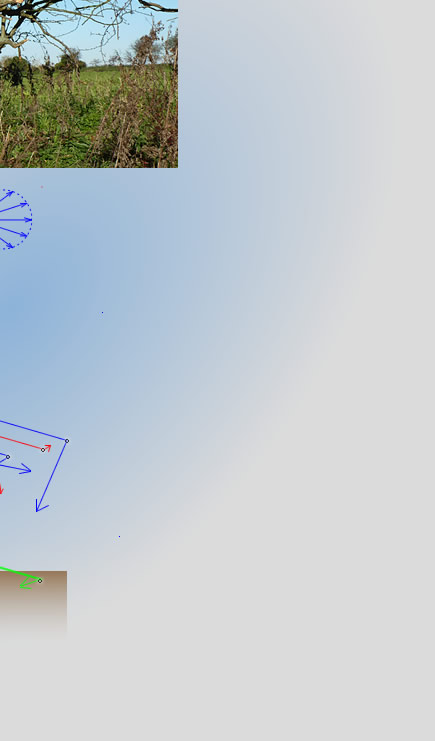Why is the Sky Blue?
Beyond the freshly cut hedgerow a blue sky grades to near white towards the horizon. Image ©Les Cowley
Blue skies make the heart soar and poets rush for quill and ink.
The blue dome has subtle variety. Overhead it is darker - noticeably so from mountains or airplanes. Near the horizon it pales almost to white. The best skies are after heavy rain has washed out dust and aerosol saying the colour is conjured from sunlight and pure air alone.
The sun's light is a mix of violet, blues, greens through to reds. Blues and violets have the shortest wavelengths, that of blue is ~450 nanometres or 0.45 thousandths of a mm.
Air molecules, mostly nitrogen and oxygen, are 1000X smaller still. They interact only very weakly with visible light but with their enormous numbers in the atmosphere we see the effects.
Air molecules individually scatter sunlight it into all directions. Blue light is scattered much more strongly than longer wavelengths. The air above us looks blue from that scattered sunlight.
At the risk of disillusioning poets, it is not a pure blue. All other colours are scattered as well but progressively more weakly towards red.
Why is the sky whiter near the horizon? Overhead there are only a few miles of dense atmosphere and sunlight photons are scattered once - if at all. Near the horizon the air path is 10X or more longer. Along it, photons are scattered several times and the reds and greens eventually become as strong as blues to yield white. The near horizon sky cannot become arbitrarily bright with the extra scattering because beyond a certain atmospheric path length it effectively becomes opaque. In fact the sky often darkens slightly very close to the horizon for this reason.
Rayleigh scattering:
When scatterering particles are much smaller than the wavelength of light the process is known as Rayleigh scattering after Lord Rayleigh, John William Strutt, (1842 - 1919) who first described it mathematically. The scattering is inversely proportional to the fourth power of the wavelength. For example, blue light of 450nm wavelength is scattered 4.4X more strongly than 650nm red light. The wavelength dependence come from the extent of coupling between the frequencies associated with bound electrons within the atoms and the oscillating electric field of the light waves. Coupling increases as the oscillation frequencies get more similar.
Rayleigh scattering requires that there be no coherence between the individual scatterers. In dense gases when molecules are closer together this condition is not satisfied and light is predominantly scattered forwards rather than in all directions. In dense gases and liquids another process can operate, Einstein-Smoluchowski scattering. Molecular motion and collisions produce exceedingly transient local density and refractive index fluctuations that act as scattering centres. The wavelength dependence is the same as for Rayleigh scattering.
Violet sky?
Violet is shorter wavelength than blue and is scattered more strongly. The sky is not violet because sunlight is weaker in violet compared to blue and the eye is less sensitive to it.
Dust, aerosol, moisture:
All these desaturate the sky's blue to give in the limit a milky white. These scatterers are of comparable size or larger than light wavelengths and they scatter all colours more or less equally (Mie scattering).
Other worlds:
Space artists love green skies, see that in "Forbidden Planet". Sadly, all gases act as Rayleigh scatterers and would give blue skies in the absence of dust or aerosol. The exceptions are when gaseous components absorb light, like chlorine or nitrogen dioxide, to give a coloured sky. Dust and aerosol also colour. The thin Martian atmosphere is pink from its high dust content.
|

![]() Home
Home 




